|
In a world of roadways and air planes, it's hard to imagine a time when railways were the lifeblood of the country. The simple fact remains, that many towns that are still populated today, plus dozens upon dozens of other communities that have sadly folded and vanished, are where they are because of the railway companies that connected one end of this country to another. The town of Stettler is certainly no different. |
 |
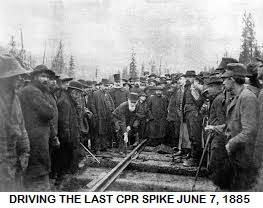 The Canadian Pacific Railway company, started in December 1871 as part of a federal promise to the newest member of the Confederation (B.C), to build a railway connecting the western province to the rest of Canada. After several rough starts (including the first company to be called Canadian Pacific, which only had 1 Canadian founder/employee, and was secretively created to connect existing Canadian rail to American ports) the Canadian Pacific Railway started it's efforts across the country. The CP track crews would reach Calgary Alberta in August of 1883, and would reach it's destined linking point in Craigellachie B.C in 1885
The team working west-to-east arrived in Craigellachie in late September. The east-to-west crew wouldn't reach the meeting point until November.
The Canadian Pacific Railway company, started in December 1871 as part of a federal promise to the newest member of the Confederation (B.C), to build a railway connecting the western province to the rest of Canada. After several rough starts (including the first company to be called Canadian Pacific, which only had 1 Canadian founder/employee, and was secretively created to connect existing Canadian rail to American ports) the Canadian Pacific Railway started it's efforts across the country. The CP track crews would reach Calgary Alberta in August of 1883, and would reach it's destined linking point in Craigellachie B.C in 1885
The team working west-to-east arrived in Craigellachie in late September. The east-to-west crew wouldn't reach the meeting point until November. |
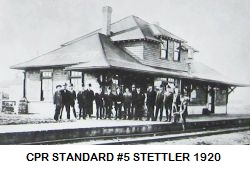 Canadian Pacific would become the first railway company to build a station on the township area that would later become the town of Stettler. In 1905, as part of the completed Lacombe spur, Canadian Pacific Railway built their standard #5 station on the townsite. Standard #5 was essentially the same as Canadian Pacific Railway's Standard #10, which was also a common station design in the prairies. Like most railway stations, there were sometimes different variations to the layouts based on what sort of setup was neccessary at each location, however the basic #5 (also called #10-small) was as follows: The standard footprint was 50'X 22' with a general waiting room, and a ladies' waiting room, and an office. The freight area would often vary in size. The station agent's family would have use of the four small bedrooms on the upper floor. Rail crews would sometimes have use of the upper floor as well dependent upon the situation. Although this station was the most common of it's time, and was used in such local communites as Botha, Halkirk and Alix it is not believed to be in existence anywhere in the province, however there is one in Manitoba. The Stettler #5 station, would burn down in 1925, and be replaced by a 14A station on the same site. Canadian Pacific would become the first railway company to build a station on the township area that would later become the town of Stettler. In 1905, as part of the completed Lacombe spur, Canadian Pacific Railway built their standard #5 station on the townsite. Standard #5 was essentially the same as Canadian Pacific Railway's Standard #10, which was also a common station design in the prairies. Like most railway stations, there were sometimes different variations to the layouts based on what sort of setup was neccessary at each location, however the basic #5 (also called #10-small) was as follows: The standard footprint was 50'X 22' with a general waiting room, and a ladies' waiting room, and an office. The freight area would often vary in size. The station agent's family would have use of the four small bedrooms on the upper floor. Rail crews would sometimes have use of the upper floor as well dependent upon the situation. Although this station was the most common of it's time, and was used in such local communites as Botha, Halkirk and Alix it is not believed to be in existence anywhere in the province, however there is one in Manitoba. The Stettler #5 station, would burn down in 1925, and be replaced by a 14A station on the same site. 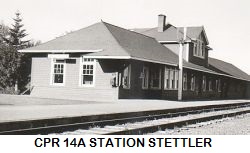 The 14A design was a smaller station, and reflected the shifting times of the railroads. A major change to the 14A was that there were only two upper floor rooms, as opposed to the 4 of the earlier station. Stettler's 14A station, was decommissioned in1968(as well as many other stations of it's type) and sadly torn down. In that time, the small fledgling community of Stettler would grow at a rather rapid pace, as well as the arrival of Canadian Northern Railway at the opposite end of town. The 14A design was a smaller station, and reflected the shifting times of the railroads. A major change to the 14A was that there were only two upper floor rooms, as opposed to the 4 of the earlier station. Stettler's 14A station, was decommissioned in1968(as well as many other stations of it's type) and sadly torn down. In that time, the small fledgling community of Stettler would grow at a rather rapid pace, as well as the arrival of Canadian Northern Railway at the opposite end of town.
Other Canadian Pacific stations along the Lacombe spur, would include a #10 Station in Castor built in 1910. It would burn down in 1937 and be replaced by an A2 Western station relocated from Loyalist. The A2 station would also be built in Clive(built: 1912 sold:1968) Nevis (built: 1912 sold: 1964) Erskine(built: 1910 demolished:1968) and Consort(built: 1912 burned down: 1957). Coronation's station was a joint operation between Canadian Pacific and Canadian Northern Railway (part of Canadian National Railway) It was demolished in 1988. |
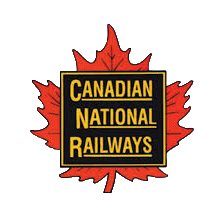 |
| The Canadian National Railway Company, was incorporated in June of 1919 as a holding company for various railway operations that had been added to the government's portfolio in the early 1900's. However even though it was already in control of the Canadian Northern Railway (CNoR), it would not become the complete network of CN rail until 1923 when it acquired control of the Grand Trunk Railway. Where Canadian Pacific, was one company from the start, and primarily built, and funded by taxpayers, Canadian National was an amalgamation of existing companies that had essentially been private with some government subsidy. The main goal of the CNoR was more to provide a service, and often many of the routes were built based on political influence, and not so much revenue potential. With the line through Stettler, it was part of a mainly provincially funded company called the Alberta Midland Railway company. AMR was a small CNoR subsidiary incorporated in 1909 and funded to build short service lines from Calgary to Edmonton. It would soon be fully amalgamated into CNoR once the AMR had been paid for their end product. The CNoR mainline from the east, would cross into Edmonton in 1906, with 132 prairie towns springing up along their line. By the time, the CNoR line was completed, it's owners were over extended financially, and when available capital dried up at the outbreak of the war, Canadian Northern's largest creditor, was the Canadian government, who took over the company in 1917. |
Although the town of Stettler was the original destination for CP railway's Lacombe spur in 1905, it wasn't originally Canadian Northern's choice to run their southbound line
from the Brazeau coal fields. It would take a great deal of effort from several local groups, to get them to build in Stettler. (Read more). However major players in the early days of the town's development, such as C.W. Willis, who had recently taken ownership of the Stettler Independent, pushed to have the railway company change their minds, and after putting pressure on Ottawa and the province of Alberta, they were successful. Brazeau coal fields. It would take a great deal of effort from several local groups, to get them to build in Stettler. (Read more). However major players in the early days of the town's development, such as C.W. Willis, who had recently taken ownership of the Stettler Independent, pushed to have the railway company change their minds, and after putting pressure on Ottawa and the province of Alberta, they were successful.
Stettler's CN station was their 2nd Class (plan 39) Station and was built in 1911. The same type of station also be built in Big Valley in 1912. Thankfully, both these stations have been not only left standing, but very well preserved. The Stettler Station, was moved to the Town and Country Museum, while the Big Valley Station, still receives visitors as part of the Alberta Prairie Railway excursions. 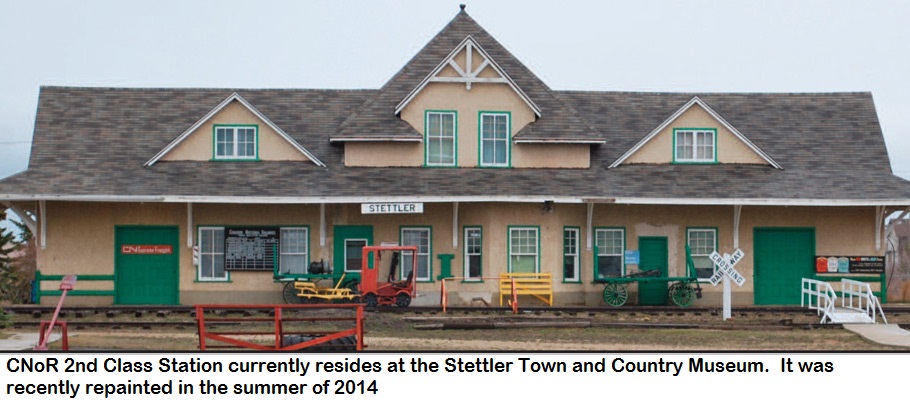 Big Valley would also be the site of the Roundhouse, making it a major point on the North-South line. Big Valley would also be the site of the Roundhouse, making it a major point on the North-South line.
Other stations in the area that would eventually become property of the CN railway, although many started out as the Canadian Northern Western Railway, or the Alberta Midland Railway
. These stations included the CNoR 3rd Class (plan 29) stations of Alix (built 1912 abandoned 1922. Relocated 1927 to Three Hills. Demolished 1975), Nevis(built 1912, sold 1962), and Camrose (built 1911. Closed 1988, relocated 1993. Still an active museum) The Warden jct Station was originally a 4th Class Station destroyed by fire in 1919, and replaced by a 3rd Class Station (plan 75). It was sold and demolished in 1984. The Warden Station was located where the CNWR line from Nordegg connected to the AMR/CNoR North-South line passing through Stettler and Big Valley. Similar design stations were also present at Rowley, and along the sub-line between Calgary and Drumheller.
|



 The 14A design was a smaller station, and reflected the shifting times of the railroads. A major change to the 14A was that there were only two upper floor rooms, as opposed to the 4 of the earlier station. Stettler's 14A station, was decommissioned in1968(as well as many other stations of it's type) and sadly torn down. In that time, the small fledgling community of Stettler would grow at a rather rapid pace, as well as the arrival of Canadian Northern Railway at the opposite end of town.
The 14A design was a smaller station, and reflected the shifting times of the railroads. A major change to the 14A was that there were only two upper floor rooms, as opposed to the 4 of the earlier station. Stettler's 14A station, was decommissioned in1968(as well as many other stations of it's type) and sadly torn down. In that time, the small fledgling community of Stettler would grow at a rather rapid pace, as well as the arrival of Canadian Northern Railway at the opposite end of town.
 Brazeau coal fields. It would take a great deal of effort from several local groups, to get them to build in Stettler. (Read more). However major players in the early days of the town's development, such as C.W. Willis, who had recently taken ownership of the Stettler Independent, pushed to have the railway company change their minds, and after putting pressure on Ottawa and the province of Alberta, they were successful.
Brazeau coal fields. It would take a great deal of effort from several local groups, to get them to build in Stettler. (Read more). However major players in the early days of the town's development, such as C.W. Willis, who had recently taken ownership of the Stettler Independent, pushed to have the railway company change their minds, and after putting pressure on Ottawa and the province of Alberta, they were successful. Big Valley would also be the site of the Roundhouse, making it a major point on the North-South line.
Big Valley would also be the site of the Roundhouse, making it a major point on the North-South line.